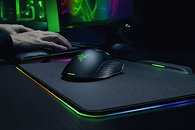- Joined
- Oct 9, 2007
- Messages
- 47,586 (7.45/day)
- Location
- Dublin, Ireland
| System Name | RBMK-1000 |
|---|---|
| Processor | AMD Ryzen 7 5700G |
| Motherboard | ASUS ROG Strix B450-E Gaming |
| Cooling | DeepCool Gammax L240 V2 |
| Memory | 2x 8GB G.Skill Sniper X |
| Video Card(s) | Palit GeForce RTX 2080 SUPER GameRock |
| Storage | Western Digital Black NVMe 512GB |
| Display(s) | BenQ 1440p 60 Hz 27-inch |
| Case | Corsair Carbide 100R |
| Audio Device(s) | ASUS SupremeFX S1220A |
| Power Supply | Cooler Master MWE Gold 650W |
| Mouse | ASUS ROG Strix Impact |
| Keyboard | Gamdias Hermes E2 |
| Software | Windows 11 Pro |
Razer 2018 International CES, demonstrated its solution to the biggest complaint serious gamers have with wireless gaming mice - their weight. Wireless mice run on batteries, and even if not bulky AAA ones, the relatively lighter lithium ion batteries in some of the more expensive wireless mice still add unnecessary weight that affects gameplay, particularly in games that demand rapid mouse movements. This isn't that much of a problem for non-gamers. Razer's solution to the problem is an implementation of electromagnetic induction, the same phenomenon that enables things like wireless charging, transformers, and modern human civilization to function.
The new Razer Mamba HyperFlux is a two-piece product - first is the mouse itself, that looks like a Razer Mamba, one of the company's most popular ambidextrous gaming mice; and second - the Razer Firefly HyperFlux mousepad. This is a medium-size, 4:3 cloth mousepad, which has an induction coil underneath. The surface is detachable (for cleaning). The mousepad plugs into one of your USB ports for power, while the mouse talks to your PC over a wireless USB dongle. The mouse needs this particular mousepad to function, which sparks an interesting debate on the logic behind this product.



Is the mouse truly wireless when its mousepad needs to be plugged in? At least being a wireless mouse without a battery, it's feather light, and solves the problem of weight and drag of a cord (solved only partially using a mouse bungee). On the other hand, it presents its own set of problems such as the added Z-height of the special mousepad (and its impact on your carpal tunnel), on what happens to the mouse when you rapidly lift it off the pad in the middle of the game, etc. I guess we'll have the answers to these questions and more when the Razer Mamba HyperFlux + Firefly HyperFlux combo hits shelves later this quarter (before April), at USD $249.99.
View at TechPowerUp Main Site
The new Razer Mamba HyperFlux is a two-piece product - first is the mouse itself, that looks like a Razer Mamba, one of the company's most popular ambidextrous gaming mice; and second - the Razer Firefly HyperFlux mousepad. This is a medium-size, 4:3 cloth mousepad, which has an induction coil underneath. The surface is detachable (for cleaning). The mousepad plugs into one of your USB ports for power, while the mouse talks to your PC over a wireless USB dongle. The mouse needs this particular mousepad to function, which sparks an interesting debate on the logic behind this product.



Is the mouse truly wireless when its mousepad needs to be plugged in? At least being a wireless mouse without a battery, it's feather light, and solves the problem of weight and drag of a cord (solved only partially using a mouse bungee). On the other hand, it presents its own set of problems such as the added Z-height of the special mousepad (and its impact on your carpal tunnel), on what happens to the mouse when you rapidly lift it off the pad in the middle of the game, etc. I guess we'll have the answers to these questions and more when the Razer Mamba HyperFlux + Firefly HyperFlux combo hits shelves later this quarter (before April), at USD $249.99.
View at TechPowerUp Main Site




